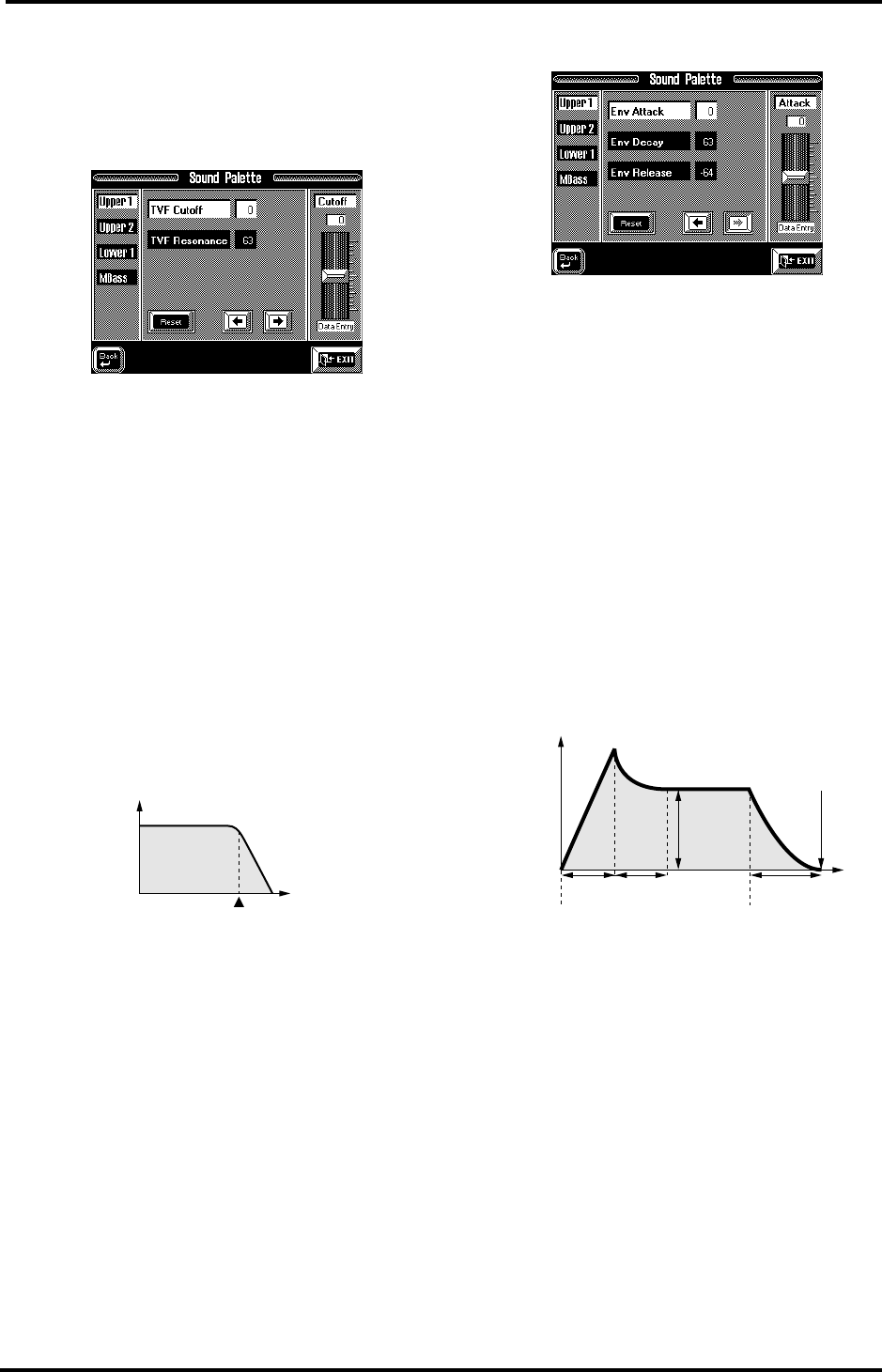
VA-76 Owner’s Manual—Mixer, effects and editing
126
Note: There are additional modulation parameters that can
be controlled via the Aftertouch (see page 189). Use them
for WahWah (TVF modulation) or tremolo (amplitude
modulation).
Timbre (TVF)
By modifying the filter settings, you can control the
timbre (tone) of the sound. The VA-76 uses Low-Pass
Filters (LPF) that allow only frequencies below the
specified frequency to pass. The frequency where the
filter starts “cutting off” harmonics (or overtones) is
called the Cutoff Frequency. By modifying the setting
of the Cutoff Frequency you can make the sound
brighter or darker. The Cutoff Frequency can change
over time, controlled by the “envelope”. By adjusting
the filter and envelope settings, you can create sounds
that have movement and expression.
TVF Cutoff [-64~63]— Positive Cutoff settings mean
that more overtones will be allowed to pass, so that the
sound becomes brighter. The further this value is set
in the negative direction, the fewer overtones will be
allowed to pass, and the sound will become softer
(darker).
Note: For some sounds, positive (+) Cutoff settings will
cause no noticeable change because the preprogrammed
Cutoff parameter is already set to its maximum value.
TVF Resonance [–64~63]— This is a parameter one
invariably associates with a synthesizer. When the Res-
onance value is increased, the overtones in the area of
the cutoff frequency will be emphasized, creating a
sound with a strong character.
Note: For some sounds, negative (–) settings of Resonance
may produce no noticeable change because the Resonance is
already set to the minimum value.
Envelope
The volume of an instrument changes with time, from
the moment the note begins to sound to when it dis-
appears. This change can be indicated on a graph as
shown below. The envelope shape is unique to each
instrument, and is an important element in how we
distinguish the sounds we hear. The envelopes of
musical instrument sounds can change depending on
how the instrument is played. For example if a trum-
pet is played sharply and strongly, the attack will be
quick and the sound will be sharp. But if a trumpet is
played lightly and softly, the attack will be softer. In
order to adjust the attack of a sound, you can modify
the Attack Time of the envelope. By modifying the val-
ues of the envelope you can simulate the characteris-
tics of many different instruments.
The envelope parameters affect both the volume (or
amplitude) and the filter. If the cutoff frequency has
been lowered, it will rise as the envelope rises, and will
fall as the envelope falls.
Env Attack [–64~63]— This parameter adjusts the
onset of the sound. Negative values speed up the
attack, so that the sound becomes more aggressive.
Env Decay [–64 ~63]— This parameter adjusts the
time over which the sound will fall from the highest
point of the attack down to the sustain level.
Note: Percussive sounds usually have a sustain level of 0.
Piano and guitar sounds are in this category. Holding the
keys for a long time will thus have little effect on the dura-
tion of the notes you are playing.
Env Release [–64~63]— This parameter adjusts the
time over which the sound will decay after the note is
released until it is no longer heard. The cutoff fre-
quency will also fall according to this setting.
Level
Low pass filter characteristics
Cutoff frequency
Frequency
Volume
This is where
you play a note
(Note-on)
Attack Decay Release
This is where you
release the key
(Note-off)
Sound ends
Sustain
Level
Time
VA-76.book Page 126 Friday, January 12, 2001 12:35 PM


















